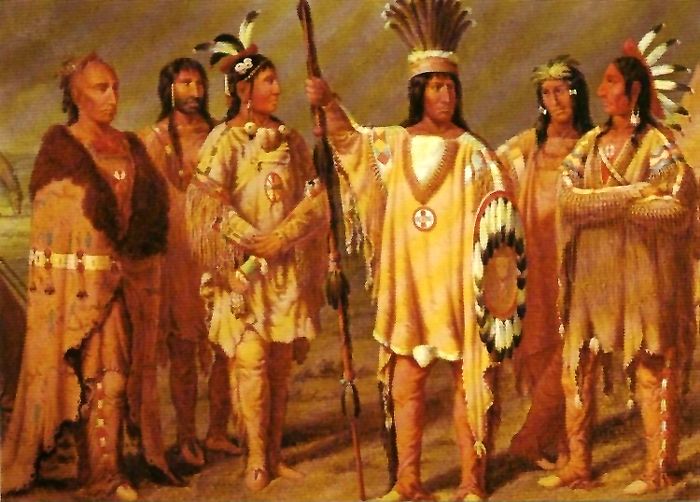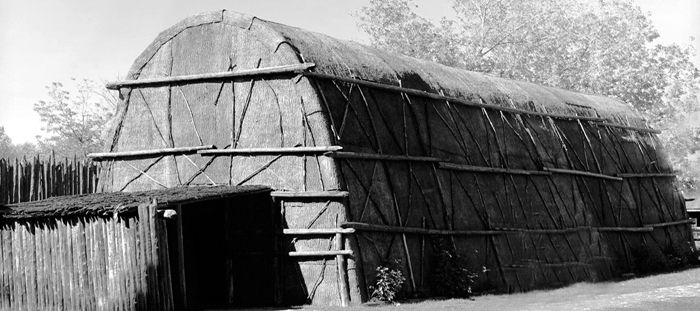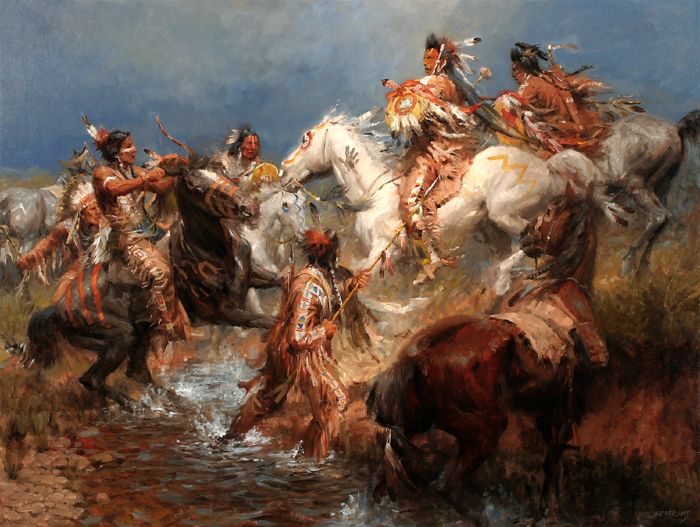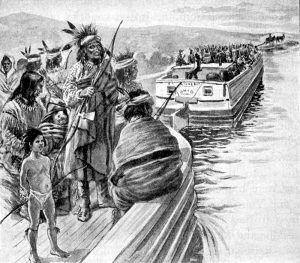The Wyandot or Huron are an Iroquoian-speaking people made up of several bands whose ancestral lands were in southern Ontario, Canada. They later moved to Michigan, Ohio, Kansas, and Oklahoma.
They called themselves “Wendat,” meaning “island people” or “dwellers on a peninsula.” Their name was rendered variously as Guyandot, Guyandotte, Ouendat, and Wyandotte. The French, however, called members of a four-band group Huron, a derogatory name derived from their word “here,” meaning rough or ruffian. This has persisted as their usual name in Canada.
Like other Iroquoian peoples, they were farmers who supplemented their diet with hunting and fishing. The women cultivated several varieties of corn, squash, and beans and collected nuts, fruit, and wild roots. The men did the hunting and fishing and built houses, canoes, and tools. They lived in longhouses, similar to other Iroquoian cultural groups, in villages fortified against enemy attack. They engaged in trade with neighboring tribes, especially for tobacco. Like other Iroquoian peoples, the Wyandot had a matrilineal kinship system, and children were considered born to the mother’s family and took their status from hers.
The people first made contact with Europeans after the French began to explore North America in the 17th century. When the tribe heard about these newcomers, some Wyandot decided to meet them in Quebec and allied with the French in 1609. At this time, the number of people was estimated at 30,000.
In 1639, they were described by Jesuit missionary Francois du Peron:
“They are robust, and all are much taller than the French. Their only covering is a beaver skin, which they wear upon their shoulders in the form of a mantle; shoes and leggings in winter, a tobacco pouch behind the back, a pipe in the hand; around their necks and arms bead necklaces and bracelets of porcelain; they also suspend these from their ears and around their locks of hair. They grease their hair and faces; they also streak their faces with black and red paint.”
By this time, they had been devastated by European infectious diseases, such as measles and smallpox. The Jesuits recorded their number as 20,000, living in 32 villages with 700 dwellings.
Though they were of Iroquois lineage, they had a long history of wars with the fierce Iroquois Confederacy. These wars continued once the French and English became involved in the fur trade business. The conflict between many tribes intensified as they struggled to control the lucrative fur trade and satisfy European demand. The French allied with the Wyandot, and the Iroquois allied first with the Dutch and later with the English. In March 1649, an Iroquois party of about 1000 warriors entered the Wyandot country, burned their villages, and killed 300 people. The Iroquois also killed many Jesuit missionaries, and those who survived burned the mission to prevent its capture. The extensive Iroquois attack shocked and frightened the surviving Wyandot. In May, they burned 15 of their villages to prevent their stores from being taken and fled as refugees to surrounding tribes. About 10,000 fled to Christian Island in Lake Huron. Most who fled to the island starved over the winter. Those who survived relocated to an area near Quebec City, Canada.
In the late 17th century, the Wyandot merged with the remnants of other tribes that the Iroquois, including the Tionontati, had overrun. It moved into lower Michigan and northern Ohio.
The Wyandot became allies of the French, fighting against the British during the French and Indian War from 1754 to 1763. However, they fought with the British during the American Revolution of 1775-1783. Near the war’s end, the Wyandot were regarded as fierce warriors. When Colonel William Crawford led an expedition against them at Upper Sandusky, Ohio, in 1782, his army was defeated, and Crawford was burned at the stake. On another occasion, when General Anthony Wayne ordered Captain William Wells to go to Upper Sandusky and bring in a prisoner who could tell them about the American Indians’ plans, Wells replied that he “could bring in a prisoner, but not from Sandusky, because there were none, but Wyandot at Sandusky and they would not be taken alive.”
When the Northwest Indian War began in 1785, the United States and a confederation of numerous Native American tribes fought to control the Northwest Territory. The British aided the tribes. In the Battle of Fallen Timbers in 1794, General Anthony Wayne defeated the Wyandot and other Ohio-American Indian peoples. The Treaty of Greenville in August 1795 ended the war, and the Wyandot surrendered most of their Ohio lands. They ceded more land in northern Ohio and southern Michigan in the Treaty of Detroit in 1807.
In 1842, under the increasingly aggressive U.S. Indian Removal policy, the Wyandot were made to give up their claims to their reservation at Upper Sandusky, Ohio. The following year, they were sent to a reservation in what is now Wyandotte County, Kansas. After the Civil War, the Ohio Wyandot were removed to Oklahoma.
Today, the Wyandot have four bands with recognition in the U.S. and Canada:
- Wyandot Nation of Kansas – About 400 members are headquartered in Kansas City, Kansas.
- Wyandotte Nation of Oklahoma – A federally recognized tribe headquartered in Wyandotte, Oklahoma, with about 4,300 members.
- Huron-Wendat Nation – Located just outside Quebec City in Canada, with some 3,000 members
- Wyandot Nation of Anderdon – Headquartered in Trenton, Michigan, with about 800 members
In February 1985, the U.S. government agreed to pay descendants of the Wyandot Indians $5.5 million in partial compensation for the exploitative treaty of 1842.
In 1999, representatives of the far-flung Wyandot bands of Quebec, Kansas, Oklahoma, and Michigan gathered at their historic homeland in Midland, Ontario, and formally re-established the Wendat Confederacy.
© Kathy AlexanderLegends of America, updated March 2024.
Also See:
Native American Photo Galleries
Native Americans – First Owners of America
Sources:
Cutler, William G. Cutler; History of the State of Kansas, T. Andreas, Chicago, IL, 1883
Ohio History
Wikipedia




